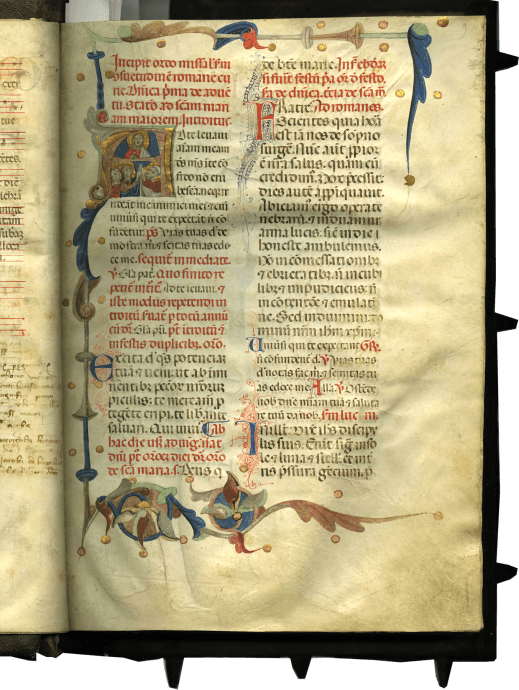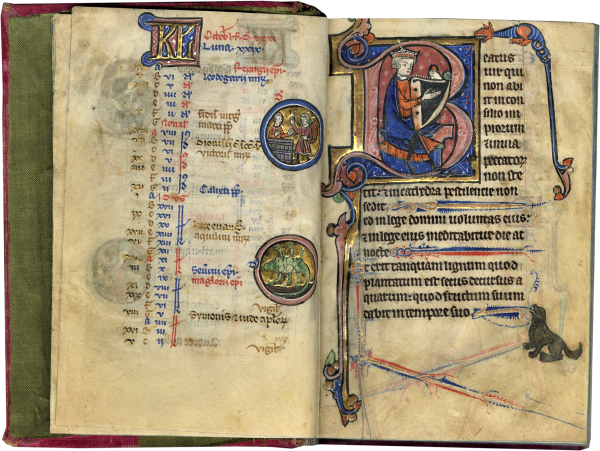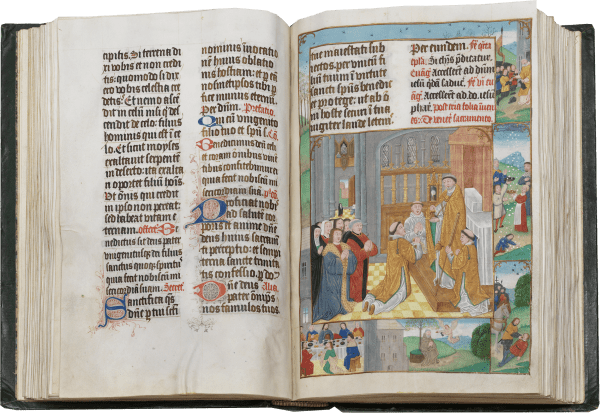


Missal, Use of Rome
, Northern Italy (Parma?), c. 1280-1320




Missal, Use of Rome
Description
i (heavy soft paper) + 264 + i, foliated in pencil top outer corner recto, now bound out of order, lacking at least two leaves (i8 ii10 iii6 iv2 v10 vi10 [-1, before f. 37] vii-xvi10 xvii10 [-1, before f. 146] xviii-xxviii10], horizontal catchwords lower inner margins, ruled very lightly in lead (justification 240 x 160 mm.), copied in two columns of thirty lines in a rounded gothic bookhand by two scribes, the second scribe beginning on f. 52v, one-line initials alternately red and blue, two-line alternately red and blue initials with violet or red pen decoration, numerous three-line alternately dusky pink or light purple initials on blue or pink grounds, infilled with orange or blue acanthus, with acanthus leaves either extending from the initials into the margins or painted as detached independent leaves, border on f. 1 with initial of this type, twenty-two historiated initials, eight historiated initials with borders, six elaborate borders with roundels depicting scenes, most also with historiated initials (described in detail below), in good condition apart from signs of use including dirt in the bottom outer corners, ff. 16, 17, rectangles cut from the lower margins, now patched. Bound in very heavy think boards, not beveled, cut square, covered in brown leather, spine with five raised bands, extensive hardware, bosses (four corner and center), and spikes on fore-edge, rebacked, in excellent condition. Dimensions 353 x 249 mm.
A fully illuminated Missal by a skilled and inventive artist, browsing the painted pages of this large volume is a delight. The hierarchy of decoration proceeds from the six pages decorated with elaborate borders (including vignettes painted in roundels in the margins), eight historiated initials with borders, twenty-two historiated initials, and to painted initials that are too numerous to count. Owned by a noble family from San Secondo Parmense–and almost certainly kept in their family chapel–the calendar includes records of births in the family over many generations.
Provenance
1. Written and illuminated in Northern Italy, perhaps in Parma, at the end of the thirteenth or early in the fourteenth century (it must date after 1255, since it includes the feast of Clare on August 15). The extensive family notes added to the calendar are evidence that it was owned by the Rossi family, counts and later marquesses of San Secondo (now San Secondo Parmense), a town about fifteen kilometers northwest of Parma, and it is possible it was made for a member of the Rossi family.
The Missal follows use of Rome (also the basis of the Franciscan liturgy); the feasts included in the calendar suggest that this dates, at the latest, from the early fourteenth century, since important feasts observed after this date are lacking including Peter Celestine (1313), Louis of Toulouse (1317), Thomas Aquinas (1323), and the Visitation (1389). Note that the important Franciscan saints are not in red: Anthony of Padua (13 June), Clare (15 August), Francis (October 8), and his translation (May 25), and Elizabeth of Hungary (19 November).
2. The Rossi family is known from the twelfth century, and throughout the thirteenth century had lands in Parma, Reggio, Cremona, Lucca, and elsewhere, as well as in San Secondo. In 1365, Ugolino de’ Rossi, Bishop of Parma, allowed the sale of lands in San Secondo owned by the chapter of the cathedral of Parma to his nephews, Bertrando and Giacomo de’ Rossi. Giacomo became the first count of San Secondo, and the family’s power was centered there from that date. Their surviving castle in San Secondo (the Rocca dei Rossi) dates from 1513 and was built by Pier Maria I de’ Rossi.
These family notes record births and a few deaths in the Rossi family for generations. They provide strong evidence that this Missal was from the Rossi’s private chapel, perhaps from 1387 when the death of Ugolino de Rossi, bishop of Parma was recorded (see April 28), or earlier, until 1622, which appears to be the most recent entry (see November 5), recounting the children born to the Rossi counts including Pier Maria I, Pier Maria II (married to Antonio Torelli, but famous for his love affair with Bianca Pellegrini), Guido, Giovanni, Troilo and his wife, Bianca Riario, Pier Maria III, who was married to Camilla Gonzaga and who was painted by Parmigianino, and Frederico and his wife Isabella Borromeo.
Notes such as these, known in French as livres de raison, are often found in Books of Hours; in modern times, family Bibles were used in this way. Finding these notes in a Missal, which was a book used by a priest to say Mass and not a personal prayer book for lay use like a Book of Hours, is certainly unusual, and it would be very interesting to look for other examples, if there are any.
3. A reference to a Missal from the de’ Rossi family of San Secondo is included in his history of Parma by A. Pezzana, Storia della città di Parma, vol. I, 1837, p. 192, note 226. “The calendar of the Missal mentions, on the date February 18, the death of Antonio, son of Rolando Rossi” (in Zanichelli, 1996).
4. André Hachette (1873-1945) his printed ex libris with monogram in red AH on the inside front cover (not in his 1953 sale); pencil notes on the inside front cover “263 blatter”; front flyleaf, f. i, “4015.”
5. Heribert Tenschert, No. 41: Leuchtendes Mittelalter. Neue Folge II, dreiunndreissig mittelalterliche Handschriften aus Byzanz, Italien, Frankreich, Deutschland, Flandern, and den Niederlanden vom 11. bis zum Frühen 16. Jahrhundert, Passau 1998, no. 7.
6. Jörn Günther Antiquariat, Hidden Treasures: Illuminated Manuscripts and Printed Books, Hamburg 1998, no. 4.
Text
ff. 1-6v, Calendar;
ff. 7-8v, Ordinary texts for the Mass; Kyrie (noted), Gloria, Preface for Pentecost, and prayers;
ff. 9-18v, Incipit ordo missalis secundum consuetudinem romane curie. Dominica prima de aduentum statio ad sanctam mariam maiorem, …; Temporale from Advent continuing through Christmas;
ff. 19-36v, Votive Masses, Exultet (noted), Dedication of a church, and further votive Masses, these three quires (now quire 3-5), are bound of order, and once must have been found at the end of the volume;
ff. 37-194v, Temporale continues from f. 18v, beginning impf. “//tate carnis neque …”; then continuing with Stephen (December 26) to the twenty-fourth Sunday after Pentecost;
The Prefaces for Palms Sunday on f. 96v were copied with staff lines, but the music was never added; on f. 126 following Good Friday are the Exultet (noted), and the blessing of the candles; on f. 138v the Litany includes Gregory, Martin, Augustine, and Anthony; Ordinary of the Mass beginning on f. 140, with noted Prefaces on ff. 143-145v, ending mid-column b; f. 146, one leaf missing before the Canon, then the Canon with extensive margin liturgical directions, continuing through f. 147, with the Temporale recommencing on f. 147 with Easter.
ff. 195-243, Sanctorale, beginning with Andrew (November 30);
ff. 243-264v, Common of Saints, ending imperfectly f. 264v with one virgin (text is bound out of order, and would have continued with quires 3-5 above, beginning on f. 19.
Illustration
This Missal can be associated with a corpus of codices (Zanichelli, 1996) executed in Parma in the first half of the 14th century, in relation to the commission of the Rossi family and especially of the bishop Ugolino Rossi (1323-1377).
Its decoration can be compared to that of the manuscripts dating back to the early commissions of Bishop Ugolino, including especially the Pontifical MS. Add. 39760, now at the British Library, or the Antiphonary MS Pal. 210 from the Palatine Library in Parma, probably created for the women's convent of San Domenico (or for Abbess Andriola de’ Rossi, Ugolino’s niece). We can observe the same stylistic characteristics in the faces, which are consistently youthful, mostly portrayed in three-quarter view, using green skin tones typical of the Byzantine influence; there is little emphasis on anatomy, with the bodies covered in long tunics and represented only up to three-quarters in height, often with hands clasped in prayer or in a blessing gesture.
The color palate and the borders of knotted cords and acanthus, with some including roundels depicting secondary scenes, have parallels in Bolognese illumination. However, the Bolognese component is limited to the ornamental patterns, and the artist doesn’t use the Giottoesque sense of space that the Bolognese miniature had fully embraced in the 1320’s.
This is a luxurious manuscript with an ample program of illumination including illuminated initials, mostly three-line alternately dusky pink or light purple initials on blue or pink grounds, infilled with orange and blue foliage, with acanthus leaves either extending from the initial or painted as detached leaves, at the beginning of each Office, historiated initials, usually four-lines, in a similar style, and historiated initials with complex and ambitious borders, some of which include additional roundels with secondary scenes. Furthermore, the layout of the frames and letters is characterized by a metamorphic dynamism. Leaves, shells, knots, and vines and mixed with dragons, birds, and small human figures from the waist up often included on the page bending at right angles to encircle the writing area. The coloured frame that encloses the initial field is a recurring element in the Parma miniature production, lasting until the end of the following century.
The artist was imaginative and skilled; the page illustrating the Palm Sunday procession on f. 100v, for example, combines two historiated initials (one of Christ, one of the crowd), both supported with figures (a bird and a man), with a colorful border of blue, mauve, green, and orange acanthus leaves and other foliage arranged on a thin stem with an occasional knot and gold balls outlined in black, with two roundels in the lower margin, framed in acanthus leaves, of Christ entering Jerusalem, and the Crowd holding palms. This opening is markedly dirty and cockled; could this Missal have been brought outside during the Palm Sunday procession?
Subjects of the twenty-two historiated initials:
f. 17, (Christmas), Saint holding a book;
f. 18, (Second Christmas Mass), Saint;
f. 32, (Mass in honor of the Trinity), three-quarter length portrait of Christ;
f. 32, (Mass to ask for Grace), three-quarter length portrait of Christ(?);
f. 32v, (Mass in Honor of the Virgin), Virgin Mary;
f. 32v, (Mass for Peter and Paul), An apostle;
f. 38, (Mass for John the Baptist), John the Baptist;
f. 62v, (Saturday after the first Sunday in Lent), Kneeling figure;
f. 109v, (feria iv in Holy Week), Virgin Mary;
f. 182, Standing figure;
f. 196, Lucy;
f. 199v, Three-quarter length portrait of Paul with sword;
f. 218, John the Baptist;
f. 217, Peter and Paul;
f. 223, (Abdon and Sennen) Standing figure;
f. 241v, Martin;
f. 243, (Common of Saints), An apostle;
f. 247v, Standing crowned figure, praying;
f. 252v, Standing figure;
f. 258v, three-quarter length figure with halo;
f. 263v, three-quarter length figure of a monk in a white habit, black cloak;
f. 264v, Group of Virgins.
The calendar, f. 1, begins with a painted initial with and bar border with fleshy acanthus, inner, top, and extending partially into bottom and outer margins.
Eight historiated initials with borders. Subjects as follows:
f. 9, (Advent), 5-line historiated initial of Christ with two apostles and a friar, with a three-quarter border;
f. 40, Thomas of Canterbury with border in inner margin;
f. 42v, (Epiphany), Adoration of Magi, with a three-quarter border;
f. 195, (Sanctorale), Two apostles, with a border top, inner, and bottom margins, extending slightly into the outer margin;
f. 202v, (Purification), the Purification, with border top, between the columns, and in the bottom margin;
f. 206v, (Annunciation), the Annunciation; border as above;
f 227v, (Assumption of Virgin), the Assumption, depicting the apostles and the feet and dress of the Virgin; border as above;
f. 231v, (Nativity of Virgin), Virgin and St. Anne; border as above.
Six illuminated borders including roundels with additional scenes (most with historiated initials as well). Subjects as follows:
f. 41v, (Christmas Octave), Christ, a standing figure perched beneath the initial; border extends between the columns, and then into the upper and lower margins, with roundels of Mary and the Baptism of Christ;
f. 100v, (Palm Sunday Procession), two initials, 3- and 4-line, one depicting Christ, and one two young boys, watching and holding palms, with roundels of Christ’s entry into Jerusalem, and the crowd, holding palms;
f. 147, (Easter), with two roundels in the lower margin, one of the three Mary’s at the tomb, the other of an angel at the tomb;
f. 140, (Ascension), the Ascension of Christ, showing the bottom of his robe and feet, with the Apostles below in a roundel;
f. 163v, (Pentecost), with roundels of the sleeping solider, and Christ robed in white standing before the empty tomb;
f. 240, (All Saints), Christ in Majesty, blessing, with two roundels of saints in the lower margin.
This manuscript is a Missal – the liturgical book for the celebrant that includes all the texts necessary to celebrate the Mass. From the thirteenth century on Missals were the predominant book used by the celebrant during the Mass, and include the prayers for the celebrant, as well as the biblical readings, read or chanted by the sub-deacon or deacon, and the texts sung by the choir. As is stated in the opening rubric this is a Missal following the Use of the Roman Court (secundum consuetudinem romane curie), or as we would say today, Use of Rome.
This Missal was copied for use in a secular church, perhaps even for the private chapel of the Rossi family, where it was certainly by the fifteenth century. The history of the Use of the Roman Court is tied to the history of the Franciscans, the order created by St. Francis of Assisi. The Franciscan Rule of 1223 specified that the Friars were to follow the Office “according to the order of the Roman Church.” This “order of the Roman Church”–the liturgy used at the Papal Court–became the basis for the Franciscan liturgy. Franciscan Use, or Use of Rome, was destined to have a great influence on the subsequent history of the Roman liturgy, since it was the basis for the liturgy eventually mandated by the Council of Trent to be used throughout the Roman Catholic Church.
Although Use of Rome was not mandated until much later, there were many dioceses in Italy that followed this Use even as early as the thirteenth century.
We are grateful to Federica Toniolo for her expertise.
Literature
Conti, Alessandro. La miniatura bolognese : scuole e botteghe, 1270-1340, Bologna, 1981.
Hughes, Andrews. Medieval Manuscripts for Mass and Office, Toronto, 1982.
Jungmann, Joseph. The Mass of the Roman Rite: Origins and Development, tr. F.A. Brunner, New York, 1950.
Moorman, John. A History of the Franciscan Order from its Origin to the Year 1517, Oxford, 1968.
Palazzo, Eric. A History of Liturgical Books from the Beginning to the Thirteenth Century, translated by Madeline Beaumont, Collegeville, Minnesota, 1998.
Van Dijk, S. J. P. and J. Hazelden Walker. The Origins of the Roman Liturgy. The Liturgy of the Papal Court and the Franciscan Order in the Thirteenth Century, Westminster, Maryland, 1960.
Van Dijk, S. J. P., ed. Sources of the Modern Roman Liturgy: The Ordinals of Haymo of Faversham and Related Documents, 1243-1307, Leiden, 1963.
Zanichelli, Giuseppa. I conti e il minio: codici miniati dei Rossi 1325-1482, Parma, 1996.
Zanichelli, Giuseppa. “no. 5”, in Cum Picturis Ystoriatum : Codici Devozionali E Liturgici Della Biblioteca Palatina, ed. Farinelli Leonardo and Biblioteca Palatina, Parma, Modena, 2001.
Online Resources
Thurston, Herbert. “Missal,” in The Catholic Encyclopedia, vol. 10, New York, 1911.
http://www.newadvent.org/cathen/10354c.htm
Jean-Baptiste Lebigue. “Les livres de la messe. Le missel,” in Initiation aux manuscrits liturgiques, Ædilis, Publications pédagogiques, 6, Paris-Orléans, IRHT, 2007
https://cel.archives-ouvertes.fr/cel-00194063/document
Susan Boynton and Consuelo Dutschke, “Celebrating the Liturgy’s Books”:
http://ww.columbia.edu/itc/music/manuscripts
Angelo Pezzana, Storia della città di Parma, vol. I, Parma, 1837, p. 192, note 226”
https://books.google.fr/books?id=IKc0AQAAMAAJ&printsec=frontcover&hl=fr&source=gbs_ge_summary_r&cad=0#v=onepage&q&f=false
